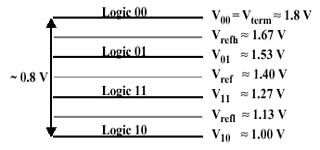Sander Sassen van HardwareCentral heeft zijn toetsenbord nuttig gebruikt door een artikel over de Rambus QRSL technologie in te kloppen. In de tekst legt hij eerst uit hoe RSL (het systeem dat nu gebruikt wordt om data van de geheugenchips naar de controller te pompen) werkt en gaat daarna verder in op de manier waarop QRSL deze snelheid nog eens verdubbeld. De techniek is in wezen simpel; door kleinere verschillen in voltage te meten kunnen meer bits in een signaal verwerkt worden, waardoor de bandbreedte toeneemt:
QRSL uses the same clockspeed as RSL, but transfers twice as many bits per clock-cycle by further subdividing the low-voltage swing into four levels. Again, like RSL, this technology proved to be very scalable as by upping the clockspeed QRSL now offers 2 Gigabits per second per pin, Gb/s/pin, versus the old 1.6Gb/s/pin.Both Rambus' RSL and QRSL signaling technologies have proven their feasibility and scalabilyty over the past year and can be found in many products, such as home PCs but also network routers and other bandwidth-hungry devices. The step up in performance does show that Rambus is able to scale their technology and compete with upcoming memory technologies such as DDR SDRAM. It will be interesting to see how well it stacks up against SDRAM and DDR SDRAM.

